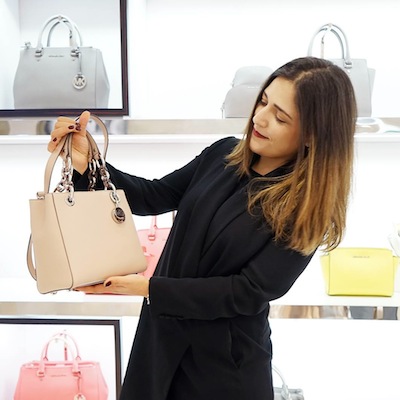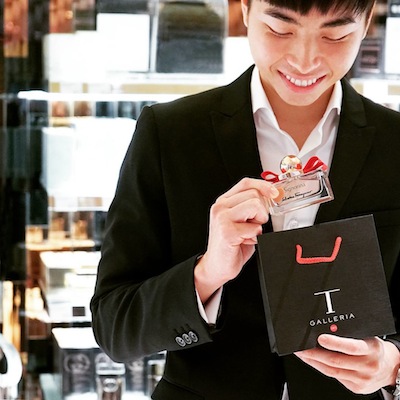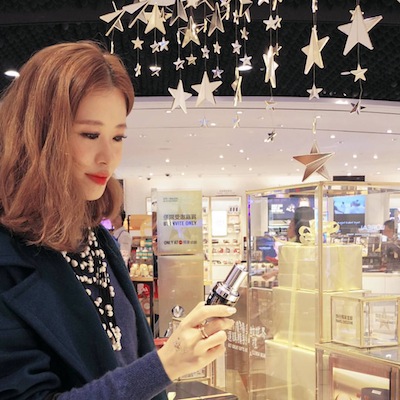A combination of increased demand for high-end brands and low-cost tourism is expected to drive the global duty-free retail market until 2019, according to a new report by Technavio.
Due to high consumer demand and affordable travel rates, the duty-free retail sector is expected to reach approximately $98 billion in revenue by 2019. As such, Technavio’s “Global Duty-Free Retailing Market 2015-2019” examines market growth by revenue and tracks emerging trends for the sector to illustrate why having a duty-free strategy can be profitable for global luxury brands.
"The global duty-free retailing market has been growing significantly because of rising consumption by the growing middle class who are traveling abroad," said Arushi Thakur, analyst at Technavio. "The fast growth in adoption of luxury goods among developing countries such as China and Brazil increased the global duty-free retailing market to $64.83 billion in 2014 from $60 billion in the previous year.
"Among all the countries, South Korea's Incheon Airport reported a record sales of $2 billion in 2014," she said. "The global duty-free retailing market is expected to grow at a CAGR of 8.57 percent for the period 2015-2019."
Retail for the traveling sect
Low-cost travel rates, due to the popularity of budget airlines such as AirTran and EasyJet, are allowing middle class consumers the opportunity to venture abroad. While overseas and spending time at the airport, consumers have a penchant for shopping as a time killer and to take advantage of the tax- and duty-free retailing available.
The inexpensive holiday trend has let APAC and Middle Eastern consumer regions develop and become the fastest growing markets for duty-free retailing. Countries such as Armenia, Oman, Qatar, India, Sri Lanka, China, Indonesia, South Korea and Turkey have emerged as the markets with the most interest in duty-free shopping.
Turkey, for instance, has plans to open the world’s largest duty-free zone within its planned Istanbul New Airport, scheduled to be completed by 2028, per The Daily Mail. When finished, the airport will have six runways and a capacity for 200 million passengers, further positioning Turkey as an instrumental crossroads between Europe and the Middle East.

DFS consumer considering a Michael Kors handbag for purchase
The duty-free market has five distinctive retailers accounting for 49.7 percent of the total revenue. LVMH-owned DFS is the largest duty-free retailer, offering more than 700 of the world's leading brands, and had a 13.1 percent revenue share of the industry in 2014.
Categories available at duty-free shops such as DFS include fashion accessories and hard luxury, fragrance and cosmetics, wine and spirits, tobacco and confectionery and fine foods. The fashion accessories and hard luxury category offers the most products, at 32.10 percent of total offerings, while perfume and cosmetics accounts for 29.21 percent of duty-free retail items.
For the apparel and accessories sector, duty-free retail was valued at nearly $20.81 billion in 2014. Commonly bought items include jewelry, briefcases, handbags and shoes, with the most popular brands being Michael Kors, Giorgio Armani, Gucci and Burberry.
Per Technavio’s research, Chinese consumers were responsible for the largest percentage of luxury duty-free purchases in 2015, contributing to nearly a quarter of all revenue.
The Chinese consumer often prefers to shop abroad and at duty-free stores due to the high taxes placed on goods at home, which in some cases can be 50 percent higher than elsewhere in the world. Technavio predicts that this aspect of duty-free retail trends will continue well into 2019.

Consumer purchasing a fragrance from DFS' T Galleria
Fragrance and personal care products are the fastest growing duty-free category and the second largest segment for the market. For 2014, the sector saw a share of 29.21 percent of the total duty-free market caused by increased international travel, foreign spending and a rise in disposable income among middle-class travelers.
Consumers from APAC and Middle Eastern countries are key regions for the fragrance and personal care market, preferring brands such as Chanel, Christian Dior, Estee Lauder and Guerlain.
In 2013, L’Oreal, whose L’Oreal Luxe division is the licensee of Armani Beauty, YSL Beauty and others, netted revenue shares of nearly 21.5 percent in perfumes and cosmetics duty-free. This resulted in the beauty group’s creation of a duty-free stores division.
To similarly capitalize on the segment's duty-free successes, Estee Lauder has established shops that offer all its luxury brands in emerging markets, such as the United Arab Emirates and at the Detroit Metro Airport, a frequent layover for Asian destinations.

Consumer considering a skincare purchase at DFS
As for the third most profitable sector sold at duty-free shops, the wine and spirits category is expected to increase to $13.47 billion by 2019. Johnnie Walker, distributed by Diageo, is the top-selling spirit for the category, along with Absolut, Jack Daniel’s, Chivas Regal and other alcohol labels.
Johnnie Walker in particular has taken advantage of duty-free retail by launching limited-edition bottles. In 2014, Johnnie Walker launched its first Johnnie Walker Gold Label Reserve Exclusive Traveller’s Edition as well as two Johnnie Walker House lounge and duty-free outposts, one in India and the other in Taiwan (see story).
Retail layover
A similar report from summer 2015 found that duty-free spending is expected to grow 51 percent by 2020.
The number of outbound international travelers is projected to reach 1 billion by 2018, creating an opportunity for luxury brands to reach a global audience through airport retail placements, according to a Conlumino report.
With more airports, lower-cost airlines and bigger planes, international travel is becoming more accessible to less affluent consumers, especially those in emerging markets. Shopping is inherently linked to tourism, and airports offer brands a captive audience that is likely to be wooed by competitive prices (see story).
In addition to price cuts, innovative retail approaches may further consumer interest in duty-free shopping.
"The global duty-free retailing market has the presence of more than 20 big retailers across all the countries," Ms. Thakur said. "Among the top countries, South Korea and China are going to be the biggest duty-free markets globally.
"Lots of opportunities for the duty-free retailing market are being created in Asia because more than 80 percent of Chinese travelers are traveling within Asia," she said. "Already, top players such as DFS and Lotte are playing a key role in these growing regions.
"They started many innovations to tap the growing opportunities such the shop and collect service, through which passengers are allowed to select products online 48 hours before and can collect them once they reach the airport."
{"ct":"Ah7koxtRFpe2SjyWoUhxnMId27tGM9ogJYy5H+9ObTAJO57htl40rVWZ9RwI+8yID\/0a0ZBxvuVdmXiVTMbmPVYc0bGXfAza39J2emgaIFcScdiKJI3nMUpmJZVmLeJN1lafyCHtUgRBYEeezH77pW2kNKAvw8s\/Ja358cxZa1WvpGAv0+sxCXEryOvyHPCoGXy++esgFjc2diGlGKfliRMISDA81c7fA9d1WuwyXKJEorguFlXtCwxOeJ9N3W7n5HVDr\/uhpdRu8ilk4JBZFX2\/U7ZRKDpRPznfdlw9pDuJnL13u3Af\/gTvK9N0oGXoEeIFslhBP0MXfncVmdQtetzkDEEu1hvhBSAGYu\/p2XOKTeix+Ic4q+e096W0x38gRssseZqo3QfpIW2pYOzZjZPIiBKT8ybjbYRNqWXGt7NpIvmRpfbDK1eXE3J4jayyaOPEnXFaTpkZO81raPhUtpYrqYqv+ol6FZfk\/KQmX8hTSblPF91rcKpdJiBXFxtnk98FuDE40wLaoX8S7ihJqWKhHjFwXWiiZOo+fPr\/dILVHrE\/wHp3SF+czBkDmt8zV1Am0fGYj+mJpRx1UsCRFLYz794X0gszamM7yQXIQEj5jSJGLSAHGFSiOjwb\/IZdx+F2xueC3UasCUfGurTsNcSkGdTV6dte1Dn+\/KjramVATFVYKSW6JI92Bi6idi2Z00meeXOsymSw5e71bVT9fXyZPGiT\/ZlHbEf3KeJket0cOxqmmFMOWFf6VQ0y77YFje5M\/WsFHDnEE9iq83AQEx18h0RFZghctBqPADETn\/pDg+NpBtdmTIMLKJGx50h5aCHiwKEvRnGkpyjKnMcHnfm7DOy1WKfOazeVzql9HC79SzAD8P2E7N57sn3SnPiaQgA9Kms7Cznn8igzJaNOG3fvHUScn\/WRPzw16C5IbLEBINcZGtn0Q4m17dqlL52PdGiifHFcsIkCCwSZhPaIhpi8y41ul9xk4pI5pSzXcJQb3OSMrEIetfLCgmb5Oyq0HT9tZAmwtR2y4ufUvRCFsU9Sq7A0jId\/WDYiKa0QQ7oaouU3lAjxoYF07y3B3yeMASC2MutFcDlQ3J1lPxgj3C+ybB+4gPPEKTn2s3HosHzjR0gkSwhFPZgvdIq+anrRV75LKqC9ffyYicMlR2XBhiZK8OHtlGGDPzir5mFMT8ygD8ocbmwF\/4HEVifRh6oJRS7+FGY6kJpU6flwzxHuCtQuRvcVAZobavav4ucxXj\/KmBux0KPkazWvBH44wOJH5lg8q275GhgygQRFaKV19ZqWek2F3Cw8nJVMrGVil+KVmFSjtdUUWZckY12ZDWKLepLpi95jhTgf\/Zf\/Rjyzf3x\/1wlDmZW3QGAGlJbf2k6BUgIZ3JooGxoXBAdLFdAwxoirMeSeseYf1Y5q\/Wf4hAkoAyQle2ueK6yrsvMqwbH2p9ftP8EHGSLANCaSPhVgXwIcY1CM3KklIf2AU91thln7k\/BnxD1j+r+H7hR2bKAJKeDvo4t+YpN2zPeAZGg7+ccYm0oJTKAp3kAMCa9F\/JACd+ebsPIMyyvT3hyrcCfoIpV3tDcbVBHtQC\/hdjdj3lFzzOutE9rWzxYY1uO\/7BvMmPs\/ZhE\/IGSMl3YTAhyFxs51+6hs+Mes2gWMyVFtGCChDmMPLVp76QRuMAghYM02tfqF3alJjX6bpT9Sv6UgLZuyvWDihKlbKIPzJyHhK2M1CVaX3aOswPpyIC4BgQu7xxk4sbb3meK8fqma1SzYk3fdZZwCxaZzyxoXuexjdKo2+wffUoi6ELaVY5ajO6PhNbYykQTDQNK56IvtPai\/2PQR3PeVPNLd723gPEwvkBJ9jIyDnu7ba5CQ4mNNsFx5EHrINI801dwHXHIN0g8sezVFd2CnpknQhijuj5DTZBnWMB2gUEaETRSpFukPt6Rx4wJ1ula4W5AOQKiP64NsUR1\/CY0f+QbeweIeTLPJgJKKlW715AQArgi4TI6E9I5nzoXsYCowAtoikTSvq5O982Tsmiu5BLf03kt8RPOnjy+ami5xG30ZoX7uR4cuVfXW1P9oESmNZkpRkuvWmPIjEWKfJuQyNMKz8TPAkZY8jRTFiWUzx2uzMe\/Ljhdi\/O65Rf00L7quD1zNqSVi2vlx5zrXK6BRakXJR+nQli6GnCKIxvoaqi+ci434tJOyskBlq4OXSSL2zRfbHq5wiBVuWZLHBpvfNfrYijDcaQ+rMd3sd+7vwwgQ0OB5Aveeax8dke6KBQaSfiCzDnlUCe47PYLEVLCHIzDKrxho1h+tUh\/e0Cvfno6LN7+ETxR2pIdpIVteWWvreLIn\/a8eQbsTxMPxgvHBEnjO8UyJHO5pIHLKEjKTXQpIqAYoSQtjyWpc9lkly6R\/mfpkLG+G\/sC+LmdRDu1wBumEMf8B4MEr1DZJWjcO0DiZqAG\/zHvmKBheywSkYB9vW3n2kBWETRdwOTBgx9hd+m3RrPqMmayhK0WUxaSenPYuDiUFr400y\/IN+wJLX+OBedBLW+j502l6MjlV1hvp2ofU2b12C3p4TJwYUAcIAF3+ihrEWGx+XRx5k1beyTU6Xf3dvU629JMua\/1TBbh1ADmi\/NPisDWU7QQm4qLTjjwscLh9MnHwnOGWoTOw0qsqRPvlLgfW8QGNGKK1hmuZl7LHCf+x2CIZDLmuMkZxg0LdG0XzJWTQyn1Avfk0y5kdbhNSTdXipG3nZ8rG4oV0FVkvy383M0AisdDMjRqDVKOrfZY9RTCdgOk5p+q5pokzS8w7ZopPiIbuoWCctzifjLTntWhHDfr8cDYcrUotvB\/6yqWqnxsMY2cBWlBFoA6N6bmFJHObwWoa0Vh797hNMXWztnBanrUlZnAF6OnJXmKXOKnEKUgDpZT+7hy1aJ+cSbIs+WKxlTbRTAnmoAz+XBZhMI7R15VP04w6z0V9EEFhaZ2SX2h1mU8tZPOiZHmn3ioE1MNEjfr3ok2ORNstHUkYQJM6MvzEi001iXqDNPyQdngXisFokN7rd9pT3AB+p\/amfgEkEuQnp6FjKDFaotShZadsipsFf\/yh3bt3kZ8saTrHtraTNai\/z1R1+dtXvP0MtqWAEXqxFNxLfIIUu+1wwU0gcu8jafTlZ0T2vEuLI\/2MOgHbDowksmzUXZHjFGrg7+JQdJk87NeHXRNRfQeZkCiZoMNm6Tmm\/tJCLTIZcQddLQQDr2kffOSyaH8yQwYf0dr2Vm45LoKP+\/28HlZz0GJeZJLzcp2cb8ZASgC2u15KBPiBC4JkRa1krUQ8zPfMJY5tTOTe4JKJ1ZAAyxWyQcJNCNu8KqCYCtMPN80hjrRFeIlVt73QwRNa+6IZztY6HqjAtvwejMX0GUfFUdKBkGStTCZUeVk3fX6j1HLLuiy\/zfkaRQ8rX1FDOpMTc4rp3MOfP\/q+3z6ckMje7zTalVSABxncCY\/tKxtwdEd9FmOwV6YXFHTGOT4NN8Je628yaoCguXaPEJhb1RgYguiOQ9wnaDsKWPp54upTuQJkpJqK\/kzKqhAsfBTceYVKtoq6JHl5lP5ZX4QsEmoDI0r3sPqr91Eym4NVzq5ZRuXWcoxxLWeDTkSX70bqplt9VkTPFVZzC0CK1BaHp9W\/s0sSnUMbgWDpuRPSYdeQOKjZrJL3kS3ipMhdOqEfVVsAVg+hJVo0qJR7Zk29VsHcVX8ibQerr0uDVNtaeddVlpof3gmZZrCKLWE9H1UbY6\/hY8SmERDCpUFM3EgpCC9FJvYn6PKybjUE2t1k2ZiBjcEInBPLlKm3LM5NPf0kdXeVvX8ekFVMZMBHrGCd8vyuU9tnPj9gaQsnMoC\/\/Q7c3Y7FkQOE7Jk\/w+L10LfibnuEcmYimJdSEmIijMQB0w4Ukw3QOCnoNrw8uJ\/OKpTnNUJrKh3imywTyvKIPqmQiLVWhrchQNFrgyjOfORA1vWwTz8G9XhweXyhKFCWLrLcM7\/oYFE7c9XVgw6ixNho8NaLxXRQ1MBXo1a0nA8+PgZ8IjpOH84ATIOLXV3jfszfjMPBC0BxrbE6BXGbVcAtocQXEhYmUzxO\/ev1PQVZpiq2zH5+EURJGCNl1ktXeK5yS+\/HIF+QOI2zeqV\/1iTQjsEM6KIY1IKSj6tB6bmvBG\/DOwN0RfMTVsqeFzqLylG5Qq1bdQw0ucFdEU1gSIEVIxYbCrdId8RfDzcLthtxCa6K+MnWmaOcNi8Ha8HirMyVh91t5e2LwmESZjLTYDF3SP+FUSsGEMIzCOk9oMpeYxUkeA7gpMfrQR79lrelRM4ISX8TsRwOggnDkBNCrUM4qz37wKyIXt2XQkWC\/8C6nAiWAguGdT9KslfwG\/5ulY7Pk5ofdUI13BG8hV+3hodBQE52c2IPU\/rOsY2Q\/Nh8tnAiyCoegx5LulyDLsu+alDsWzZ4CKieTDnYl0SFF4UFxBP6RCRKLzlCFp6D2sGYzYESZ5BgXXjE9aEeC+iWJbRORdtqfiKCVGkKuIfhL8LAfLVKXPEQe0IGh+VGZXvIZT7jIzG\/n8lLTr095ffX049ApGnPARcPxnh4ChPHKOa4So\/ZJGZdxUV2VTrqHsRD0bF\/nhpu5P4iZHQd57drItyL4MoUd\/mPvuid\/g0j7Y5pL\/z8CBukHXO3\/TsP3VEzRvJ6uNfazdnSqYN4fRvbb3eAto5\/Y9neMQVlOAHzaS4cMQ\/yTH4PW3jOJfPTG3SZpvMytC2qWoOj5HZYj78xxqNaLXhFqbTe8EmcarYfumzlNlCmt2z2N5fU0ePwQTphsLbCwORRgbYHfEfK4RN0+RdcecAvMcOIG+iRCbNOvXzaJtf7zn0Kc8kBsxum4qUyA4Abg3hQ6kI5uAQcQizLWss3cbyhfG\/7MOxyZGoqOD0JqDKqJcwvHJ9pKOv4L7X02hr\/VilI+nooNwLNsoz58YuDRsbGHLXrMGnNZZbXQ2+vEWO\/PiQ51MInJdHOjc4M7g395jCFh7QNI3IyNDUdZy99PTaTwx8QeMXLXfdySKRk38ev7xstx065mAN2WWHsMIoG4Yfuc4tf2VnhGC1ZHT72TY7sqbXozNv5pggxy4AqaUXQJ1MiE6IAtFpFIUbu\/byyr5jntOtkVeYmHKdscqdQAmHlY3FrpRPTsVyfMVwhwYp9vNCyYd23x5GH3MHhPrCHAMVUklNXP3T6Ylp+RG9pOuhaTIO\/cJC9e2NP7YCvligpiAprn4568orXJkealHP1NURT7Xe1EodPMaEFBczw7cSm6UpeXobyJb2MUVJTdtTcN2gkJRyQRsZUYoh1wLuHFNKDPYx+MxlKaeaksS6l11LsErweHCEL6KDC6nA1Lk1acl76E+mt78bq4bo6Mecf8wVduetJTxkCk2XZdY8KeJG7adEelvjbAxw0xc7XjpXnRKkSbTQskRayBrlcS\/Axk39d0b1\/gMRfNDGkNnyoq0Ol72fmczr2v5ZMeE4t1vFRGk6+nTBMU8PbuBYBjuBG7A1MiCtdtgnl6Gf9sigfimjAPL9QU04hy4kSIVyIsuJYAKOaVOVQstLPl8ZlyjCyD341QE2bimtjOpXW94eI6dJUhmrMbCJ6r4mA2H6PxYaLskGIWm7ViA9AqcdKYRb1K3KC99Ly7s5i3WKQlLF5oNicykvMLdhFeAMUTTO1ItU+krWqz3fz3ff2TX7ycHtSo8V30eFXJa0CxGzann7HKFD1kLZwrkYZp\/ZD0GAMoaCdryMviyJhz+ux9QQ6ypzQhnclSI9McjdMK4eATE0Y7leTvLTZ5b8e124tJrsu+lirxumxBQUIjWGexVRSYQxCXdh0xmCDMd1z7shlP9X6t72tGl+FS+bOg9pYVA4\/u6wQDmmaFZq2ydJ75kFAk41r7jZ0hLpwEZdExyn4\/I8Z3Lc93HeJ1pSGe+Mz+3Cf6Kf5fhseH\/0WqcLrZfqN\/gMojxsewYDTPPpcjDx4QmbAn68yBqiwDBOAQIOccihmu+EeFSmDxR4qCqS9orojlNExskH9sX1TGoUVpp98Bi2ILJbhdNyA2sQi2l+0OE7Y+BBOBMTPtuExw0wggWh91K\/qpBBMlrSVBHU0tZrhvRyRaBuDFIlfPS0yzMI2Eq0KkIbW2U3vmteCUFLQXvN4Qmks4gkdG6tW3VyO+7xacr\/zYz\/kMbWXMfdTSXO5EhuFLtoqYiLjDinpCvpUgWR13v8\/VL5Gy1a+Wo\/JhvC293Xz9znwM0gp2TiwiOYGPZA\/EKl9fjqWHQoLArjkNbtZxDeP6PBsxw9ukiZ3QKMtxERm5C50sQnrlJg+6tCjKIpNnNs80X09mvkMjIwS807agdMzV1UD3allxmpp6VC3axCGO6qUCaEGtq9uAuCqLB4861iT4LJQUuSLjZswXnpqxOYx1Kc+ijCcFLFghdUi3sRliwx6osxINFz5M1Pitu5WuB4U5Jv26xkF09gwqD\/kgiUE0rPfS0zsLUubu3MtEeMfigmnJ9C\/+Nyd0a8SV6e+fQAG6te52PGRqXeiEjkc\/8AOjk2\/d2c9xA6LpQkr\/++8ezv7YI4Ld\/1gQcVXD7lmhdXVkHbAWprpDfkhzL\/utNEm+OPZIsGgBaSaIp9sgD+1UGX4YZQYMIAL9WSetwfd5y46y7EfICDUGHsqkyEssNuwe59IRjvnhEZf9CH3PA2Js5k1LIc23JdfaYhNij2a1f\/vSzIVzgIsv6Tw+TJXSgCmDBjkXPrnqFNLiJS7MCkV29XC9H0hgdD91CzgzOjllqn7xb2r0LDL4Yzzpmpy3EPzMf846zIDGGVZ+eV0VXin3K7UglpTZlywXyVajXiIpkop\/V4woEHh8Hcxy1VShC3WAJw9DRvcdiNCQCYMvf0V+HH2ryce1z3FxLXtX\/x\/cHKwDAHmbbChUk3RlzdVpH0gAn2GcfWQXkuMW9dQzOHWtDuLHOdxkWoxuHjcGbMZHW0WkTxHpCKRonrJSi+QDGjI0qDifu62PwmSidz2cYFUzjufLKXIYJiKnDUXQyK04avTexM+g2bbn6YC3SGyqNWsUcmI+14+cdSncouevNydW1GKn6kKHPi9ugWbBTXLgvj1iJDWHdaluKdL\/Jv15jBIdCtNiynOzMHCRgmSDME7IQnG0qDyLQOyT1cV81s9zmz9XoJ6lRo6qe1DIDVSN\/WVrtGQk6CsNnY9MBMrpj8TyY+dmab7hmnAxktnEnYOCVytjruF\/UQs04o2se1Ip7a1gPr6RVp2thk6uJIv6j11Yv5fqMx1bxnPKSR1PN563h1o+GmqebksPr4iKkiK9Fwj6wvg4yos1bHS\/9t+GlHuKlOWCyWUHIKI1dBODCtL+gyQoHCa4l4xjWqZ9yp0M5bb0sTqjeF3JXh9GbiAnz0dex1khOqvzq9FPxyT9l\/kb81JTU+ppZMwqyNBlhdszJDC8wfBOqZQj9HkEPbDuB4eF06LyXHjRuYtvZBXBOxD+368\/C0FEpQJb6cwDwk6t0ppfo4+pWOQJ+Iafg47Mw33NZKStpyNDqpNG+42WnxnATg5FbQv3rRyuCULVs8izmsN9oZ2lsF\/Qu+C2g8x7LlUP4lhbQkrsBNZIXwfq\/VoGEB\/E3XuHwasxfKi7y86RCEH2K+2qD\/znC1E8wPrwmhRWt8V7x4rgzxO3g3P2NweC3DdE1X\/phR\/OpvFrvmkUKUbk18QGyk81SC4aXupJw1dr5B2MH4TuheLjrtuAdH7aTzSqRNJdpadkknXRBq9hVQm5FNdUvtUz4cDEgw0m25xKTEYmJIv8enNO1oVXpIIWvq6bav9TxPdCAknNUhanjq9mVQKwew+++tMAikXYwhEoxiIbYDvfi2qN8OynNGtvzrYQm+ABBMh+gFNQiSLYMUMim+0Ym4onzwLfYF+bdpvpqwtyJiVi880Y+kGhyUB8vUuM5L\/LOj3b7DNaJLfBo8cMPGw+02wH4k73fT5P6sdViDWNhuyeG2to\/b7+\/4EQEJHaufxZw\/+eGYRX317VdrZV7NYOVybr9j5lDC2LwKdt6HqW0XKDE3\/4gGeYePrsSHhf+PwnRQUTekXsts4Og0lSETE4rL3HA6u4g1kkTdpQjlL7+nT\/6RmHkd9+YHyq7AoOwZCQf3JBNCBur7d0pBYZwONpjWNVCpnvNzOOg2IqE5ILPrHwoL27NHTFW9RjrWN7HcTUway\/ThOfzpA5QHgTq9D7Lsice70fnqb6WmF4QvJ6N9imZhLnamyXMqhyUOXky5lySSBRbC8zGF8RE+qoLo3plUHg4a3M8poLwND3UvXDKwT5SIB0zXj17byT8JUuca5hMEeSiRfQEdYM6U\/wELwezwxfbRoFYhl81cQBGDxvmXI6oFJKucKp4nO1MaulN\/zA4MSA5U20cy+eXntM\/HizMxt26Xm3bV8jiAlt0\/bdTVEzUvCqYmwUjm2rRDjxISWedz54XZeAGuDdqdcywTpZLdcosyFU61EwWsIYBSaG+pPRxNgxTKfXtUWkGgM91jBar+jTslLCNcxVaFf\/3DaG\/j457xSqY8d5J6KjtEDFYW97yynjkyRbI\/SLsbsG9lWlXTX5G5amr7HWSZtNdX3jFHNGlFl3iUIhIt9Kxlw\/15y+14AOwREmkz0WOsvROt9FJTGnLWP8RVR+sDU\/PTRLrj9yTY1m9N2DhNvB4QEuZFNS4vTwbNLCrYPxCTbMjttbhoHDgAGhQ1VR1StcJa+nE5aRySQb9agb8PNtVsrUSpmYqXKYm8Q72EQ9c0PSJfUsSA0VJcMRcDdqnmpnmwM5i7oiMmQaokh1slBvj\/lSdajn05v4awCvxZEGpdVchlR1rGBG7LBrU0wXw0JL1HfxqiqGtyqTtzT5hZnKWmJHBntN0y5UaIHpeB0\/zQheUG4YzXEFYGWlRi\/CEC6xgCbX\/kHkTUZjhFn2sYaTEwA7TBP7ehR2XynMn4H+bVidrLrm74mW5pm9MTSfApdO4HMGIMcKgotCZSr77+4s4rgnAX0ndOAJxibM4xUCgbPf5zEJk5rcrVbFRdLImjvqHzWYRcrBVHLOwlLNw2o\/m4j2yAMm\/OtkeYeDceL5tpubTMQ\/llxbgQLTGqp3\/KJy6F5WLW6gQQgpICaVV\/jle07AEc8oONiYPsPkYMBMRg1zyrEdJJYSeFeP4qZeuUrw\/AH15mQaJuLa9qjC+p++jGXWWV\/AvsKW0gXSFdEZY8mTg+\/aTULLy6IWVlareT3TKsrCFtUaYR2pv9bvPVttoMTR6wFpWKSsDp9RKXZ4djnK2d5K5iwEG4w6jY6G4XzHcA+ak0fgb4NBbd1Op28X7+NG\/OVB71qzNYp6Lsdiar\/NJznAQDHd+yzCWUWahlA9ukDGDMxQJEQAVj6FSbAJoXDik9e0xJrIPfhpAAMeOIqdnLWozMG6czzJQUc9YPX5M9dfSGCvFg9EGUNoFzfbFaIkTBt82dkOXeyXBwEEJXqKJPQLkN+RhQYR04vY5MIIlQxoEwuEvEWyKAZrEQeJ3KW7gcx3kUH0ujLjsW9Bv3DYunCKc4gjrE2bHlsMvQ6jPcEkMn4s7UgFu+gYhvuYu+UCWw3fvFTVFqjy2unIWuf13WUuwLLLeQKBAsLKbJZ2yE7ZGNK\/gi0CfwMz06vZiodCDtIh26peTDmHoTjw4oKZ5xVy+HgFrWIXuvBA4ZAuP2H8IErVYkFgU53\/99M7mFOZ+zzUO5d7T4DQo6JRrCzJ8cD6EYHG9pVdmD6JDAok3wnHMwlZNVn9dPac9VOIpsRSGlK1yPPt6CpR+7Wq4LNcRDJXlebq2s\/J1M7jVOvo9jYephw7ua6y\/kGM9NFpmwbREHo7dNPK\/b9dsZUxh7c0\/5DlNWqlTaMKiyrB6Am5lgwSxEQtxhpVdvkn8QNJvpmkMUH5nDG5ednjwTjcz55Sl2PyPElhO\/4Vf2TgRhceRVZljVYoYfxZ+3CVxl5gGOjOLhd9YFjMmPNv0EDfTcZ6hYZaDQL6Fcp0\/XK0WaPSGHvxrXO+eAbgZo\/Elh7qFduv7wLJ1\/5fGSfqwxTbV8I8bATgO6i7MoiR3za5hmfWV5uhaAueHkW\/kN61btiEO14ZVHjVjMSjzdoOgDoPZIOsPWDqa9PT+USW9l8ETVmLs6wOLB7v7YxmIP+XgzF9Ggi2iz5lEoPWEmMBXH8lJKouhzC6GHBtubeEMnm4aaJH+bK0KpR26\/m5IjokeHqI9O1klBiEFfgvZ72HAfjpyv7naeobIgcSU3q7ALPwEqP1osBYAcyaKDB+uZwXx3yKk80vA3sFPFQ4WhPuEWiudTMvEcs3RBR+NA4xQZndIrh0IahUh5W\/JpG8ybraxdIZiFnQaDNuLXvaa8WzcN7ZyBQYybjSb6enAKnF6FrIbRv0TqlVNBpjb3u0BoVdXAPn7dO2OPWDlkArufHTFPLAf4qazYfS6gXkD3D5NxqdUdUim3b5chpHNedOhkQxXne9L1WwNCFgoT1fDJa\/7XW3m\/LACKIKKvGZuQvITbcxwUJZSMiixWDJ1T11ONrz0hdjVgRKUOfnfOSyl1FVsHaqmU0ShaNOD\/kaq\/mKur9g9dJw7TZGqum8wXjG+i\/xqmhxhf9WZfWmVGdnFdWxM5ON0\/HtJbpjQhKb8FI7BTCGjut31w29SIbu92W5NTIXuKYRtAzTkrC3IFMn9HhErEXFAP7OCv9JpteC7Vc5IyLdPKexucg8bZkkRix\/MFoVJL7E1Mt7ATWc3aGk+4cjGtfeylLME8v+mHfQBSSK62X1+qSrPoY6MLu3qa+Yq9NQHr1Xce0USXfB+ggGvtc83pA0R7M1mlz3TaYDn1T+sYC28mGOxSXTy318Sw4sJL8VGfmz61k6tVvftczPhkrR1tvseQ77TLMyS0SOObamiuTgdE0BlxXC5RMLu4jBwZT4peitknNDmNqFIe4JUYvj4LdXzcJXj8ot+Z4aRM+CtR8YhfZ9rdBeHjuvuGy3Kt50iXy5T+jW8YhQd+fDfCx\/DudfATuchTkRyO10di6kCe41DIka3bhxHjZxBtZ8KkzQ9FOAvj+nZ+NtA9gGKMegIbuTbdHG+dI7da+yIMJ+\/cGwrZdlaHNDrLWEB8iEW89q+h8jLtvcQtmqUC+8682ZK3L7xGjNKxa4L50t0G4MjVR2xNQ4dZLrVHf+7QOJsLPD5bljqQW7PX92Pf67dDkyaOHPPucJIz6kKUeZAdUizNbcHBuPn3zYCoqIfhAcR2nTQb+8AxB6+skO6QmufipCR91zeIZTpW6nfFgM4kBIq2MS8mFjCPO0VZE1SLhNL1dtAH24OZy8AFJGeIZDBBcxhRrjwlmXIGAGK5kjGCTLFg21ZKVd3SG3vXub8Oem40mFUsEqsUV+ipi+OTqn39Gf22BMglbE5dgWjRpqtcTlXDUTqoXyA1xP30ML2u5D\/zVgZwawN0lWk44pwT3pePF6F1NZSr27I2nutSl5ghaHeQdCslC6n00vWfb3g6Peh2toeZfikPIIRfky6C6kEWJzEvK8bT+hls0jK5l2JzeLP6dAfhtE0VgNWGqpu7r0Cm5k04kkdIxwZi3SL7nMPX1Vxke70gW25SBtVAM\/LPcSdzCJrcPGCnoRvae7\/GzLhNmOtr5r+gzY9xOZRDdtQ3oug37DKDeKzQY4I4CONsOnNc+0doDYwJMGpDw19JL\/bMyBh\/+lWqdVJZhXmnlLL8sqX98e+PqUoXbh1sKhwkdROEhuKX5KjbvQ\/+00QbcqgbDA+gwe7grDDH4pEGGPlnjuqvdSLBLTNithO6aQ40djCGFUa1LjiKZr6Nq\/QNC9EiVo4Di3DwPLS+GJZpel3llBzYIDm8KZPw9gBGOCHhwAGboGghP6AeB85fJik8WoGgWp5AWEB6hI98mVTrnz8T3AOh4h6Hkf2tzoAYZxwtW7oAtL8wiRdEPwwAgG+xMbtAVTJ4L2XiXHFjPDrKRcyrl3jaVlO3ltw\/2e94Smp\/9QoxLPLxHxfp77UzVFUeZ9o\/X6N9O13kqwGuaSCwVDezGwI27G\/mGMVBqsMmBslkMZ5NDgsJANPFL1JvYA97fsokGbCpYSF\/1zqIUk0IYkW896FI2nTFl+A9RTGiBOivUsBB62OlRqXDzW+6q6KnryqGg6Tu0wziumXz3FukQCA==","iv":"8be7451805a71cd7d959bb571c4f1801","s":"b9c8971db523e56e"}
